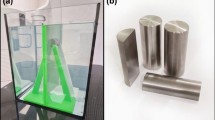Abstract
This study aims to develop a 3D printed compensator for total body irradiation (TBI) based on CT images and validate the feasibility of the proposed method using a RANDO anthropomorphic phantom. The workflow for the proposed method is as follows. First, CT images were acquired and segmented into different body regions to obtain surface information from the phantom. Second, the deficit thickness in each body region was calculated by comparing it to the maximum thickness of the body. Third, the effective attenuation coefficients of compensator materials, such as polylactic acid (PLA) and Cerrobend, were measured to fabricate a TBI compensator capable of shielding the dose for each deficiency thickness. Finally, the optimized compensator mold was converted to a standard triangle language file and manufactured using 3D printing. Dose assessment of the proposed method with the fabricated compensator was performed using a metal–oxide–semiconductor field-effect transistor (MOSFET) and EBT3 film. The average effective attenuation coefficients were 0.027, 0.393, 0.013, and 0.025 for solid water, Cerrobend, and PLA with 20% and 50% infill, respectively. While the midline-dose differences in the conventional TBI were significant, ranging from − 12.38 to 6.10% at the measured locations, those in the proposed method were less than 3%, except for the maximum value of 3.78% at the neck. In the dose profile measured by film, the overall mean absolute percentage difference of the conventional TBI was higher than that of the proposed method. In conclusion, the proposed method showed a more accurate and uniform dose than the conventional TBI. Furthermore, the proposed method could reduce the time required for treatment preparation by simplifying a portion of the overall treatment preparation process required by the conventional TBI.




Similar content being viewed by others

References
P. Richaud, G. Hoerni-Simon, R. Denepoux et al., Strahlenther. Onkol. 155, 736 (1979)
S.V. Harden, D.S. Routsis, A.R. Geater et al., Br. J. Radiol. 74, 1041 (2001)
J. Park, E.K. Choi, J.H. Kim, S. Lee et al., Radiat. Oncol. J. 32, 198 (2014)
T.H. Kirby, W.F. Hanson, D.A. Cates, Med. Phys. 15, 364 (1988)
R. Yao, D. Bernard, J. Turian et al., Med. Phys. 39, 2239 (2012)
C. Onal, A. Sonmez, G. Arslan et al., J. Radiat. Oncol. Biol. Phys. 83, 1641 (2012)
J.M. Galvin, G.J. Dangio, G. Walsh, Int. J. Radiat. Oncol. Biol. Phys. 6, 767 (1980)
M.J. Engler, Int. J. Radiat. Oncol. Biol. Phys. 12, 2033 (1986)
M.Y. Lee, B. Han, C. Jenkins et al., Med. Phys. 11, 6137 (2016)
S.Y. Park, J.I. Kim, Y.H. Joo et al., Phys. Med. Biol. 62, 3735 (2017)
B.R. Prasad, M.A. Brook, T. Smith et al., Colloids Surf. B 78, 237 (2010)
K.E. Dusenbery, B.J. Gerbi, Technical Basis of Radiation Therapy, vol. 4 (Springer, London, 2006), pp.785–804 (Chap. 31)
E.J.B. Gurp, M.A.B.J. Mijnheer, T.A.M. Verschueren et al., Int. J. Radiat. Oncol. Biol. Phys. 69, 4 (2007)
C.H. Choi, J.M. Park, S.Y. Park et al., J. Radiat. Protect. Res. 42, 2 (2017)
S. Devic, Phys. Med. 27, 122 (2011)
Acknowledgements
This work was supported by the National Research Foundation of Korea (NRF) Grant funded by the Korea government (No. 2022R1F1A1072199). This work was supported by the Seoul National University Bundang Hospital (SNUBH) Research Fund (Grant No. 2017-00583).
Author information
Authors and Affiliations
Corresponding authors
Additional information
Publisher's Note
Springer Nature remains neutral with regard to jurisdictional claims in published maps and institutional affiliations.
Rights and permissions
Springer Nature or its licensor (e.g. a society or other partner) holds exclusive rights to this article under a publishing agreement with the author(s) or other rightsholder(s); author self-archiving of the accepted manuscript version of this article is solely governed by the terms of such publishing agreement and applicable law.
About this article
Cite this article
Kang, SW., Song, C., Kim, I.A. et al. Development of 3D printed patient-specific compensator for total body irradiation based on CT images. J. Korean Phys. Soc. 83, 216–225 (2023). https://doi.org/10.1007/s40042-023-00860-4
Received:
Revised:
Accepted:
Published:
Issue Date:
DOI: https://doi.org/10.1007/s40042-023-00860-4



